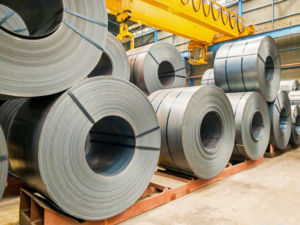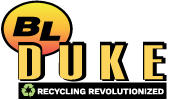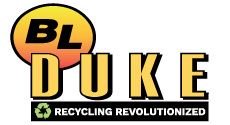
After finally reaching the floor in July, the ferrous scrap metal market settled sideways across the Midwest, suggesting a slow and steady path to a rebound in the market.
Chicago's Ferrous Scrap Market
Ferrous grades in Chicago held steady at July's price levels. Despite factors such as rising hot-rolled coil (HRC) prices, an imbalance between supply and demand, and stable pig iron prices— all of which were expected to drive a slight increase in August's scrap metal prices— we instead observed prices remaining consistent with July across the board in Chicago.
"Chicago's market is showing signs of stabilization," states Lou Plucinski, President. "Demand has improved now that we've reached the end of steel mill outages and there has been a modest rebound in the export market."

Nucor and Cleveland Cliffs' recent decision to raise spot prices for hot-rolled coil (HRC) has also given ferrous scrap sellers a boost in confidence, indicating a potential rebound in the scrap market in the coming months. This price hike suggests increased demand for steel products. This move offered some relief to scrap suppliers who have faced lower prices in recent months. On August 5, Nucor raised its weekly consumer spot price for HRC to $690 per ton. This is a $15 per ton increase from the prior week, with a $40 per ton increase in the past two weeks.
Between 2019 and 2023, the recycling industry has faced significant cost increases. Transportation costs rose by 25.13%, equipment by 34.57%, labor by 26.40%, health insurance by 167%, general liability insurance by 72.6%, and interest and capital costs by 54.50%. These rising expenses highlight the growing financial pressures on the industry, emphasizing the need for strategic planning and effective cost management.
"In 2024, mills controlling much of the supply side have complicated the monthly settlement process, causing delays and restricting material flow," says Mike Garvey, CFO. "Inefficient trades, declining prices, and rising equipment and labor costs have severely impacted the scrap industry, highlighting the need for a reset to achieve profitability."
Steel mills are increasingly moving upstream to control their scrap supply. They are purchasing scrap yards to secure a steady flow of raw materials. This strategy not only ensures control over the supply but also allows mills to manage purchase prices more effectively. Currently, the only major US mill not vertically aligned with a scrap company is US Steel.

Chicago's Nonferrous Scrap Market
In August, nonferrous metals are experiencing a significant month-over-month decline, with prices dropping substantially for copper, aluminum, and stainless steel. This decline is driven by the ongoing slowdown in the Chinese economy, a supply and demand imbalance, a strong US dollar, and current geopolitical tensions in the US. Index prices for copper, aluminum, and nickel have all fallen by at least 10% in the past 30 days, leading to a corresponding decrease in scrap metal prices this month.
Aluminum scrap prices continue to see significant decreases, with the LME price dropping 5% week over week amid weak demand. Despite this, aluminum prices are expected to moderately increase throughout the remainder of 2024. Forecasts suggest aluminum prices will range between $2,400 and $2,500 per ton, equivalent to $1.08892 per pound, which is a 10% increase from today's value. This expected rise is primarily driven by supply constraints and increasing demand from the automotive, construction, and renewable energy sectors.
 Copper prices are also falling sharply, down 12% month over month and over 20% from record highs just two months ago. The decline is largely due to the recent economic slowdown in China, exacerbated by issues in its property sector, overall reduced industrial activity, inflation concerns, geopolitical tensions, and a strong US dollar making commodities more expensive for buyers using other currencies. Copper prices are anticipated to stabilize and trend slightly upward towards the end of 2024, supported by strong demand fundamentals, particularly from the green energy sector and infrastructure projects. Despite recent volatility, the long-term outlook for copper remains positive, with ongoing investments in renewable energy and electric vehicles expected to benefit prices.
Copper prices are also falling sharply, down 12% month over month and over 20% from record highs just two months ago. The decline is largely due to the recent economic slowdown in China, exacerbated by issues in its property sector, overall reduced industrial activity, inflation concerns, geopolitical tensions, and a strong US dollar making commodities more expensive for buyers using other currencies. Copper prices are anticipated to stabilize and trend slightly upward towards the end of 2024, supported by strong demand fundamentals, particularly from the green energy sector and infrastructure projects. Despite recent volatility, the long-term outlook for copper remains positive, with ongoing investments in renewable energy and electric vehicles expected to benefit prices.
Nickel prices have also continued to erode, with the LME price falling 3.5% week over week and 10% month over month. Consequently, prices for 300 series grades of stainless-steel scrap have declined 6-7% over the past month. Contributing factors include weak domestic demand, a lackluster export market, traditional summer maintenance slowdowns, and an overall bearish market sentiment. Nickel prices are expected to remain volatile but are forecasted to rise later in 2024, driven by strong demand from the electric vehicle (EV) sector, which uses nickel extensively in battery production. Supply disruptions and geopolitical factors may also contribute to higher prices.



